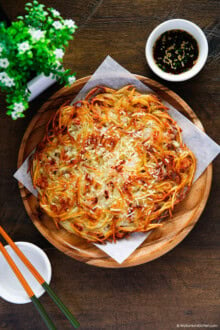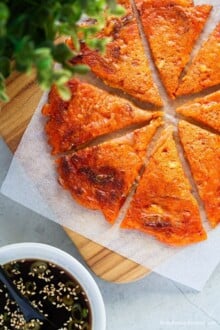Crispy Korean zucchini pancakes (hobakchae jeon) are light, savory, and full of umami from dried shrimp. Honestly, it’s one of the best pancake recipes I’ve tried recently! They make a perfect side dish or light lunch, and come together quickly with just a few simple ingredients. Give it a try!
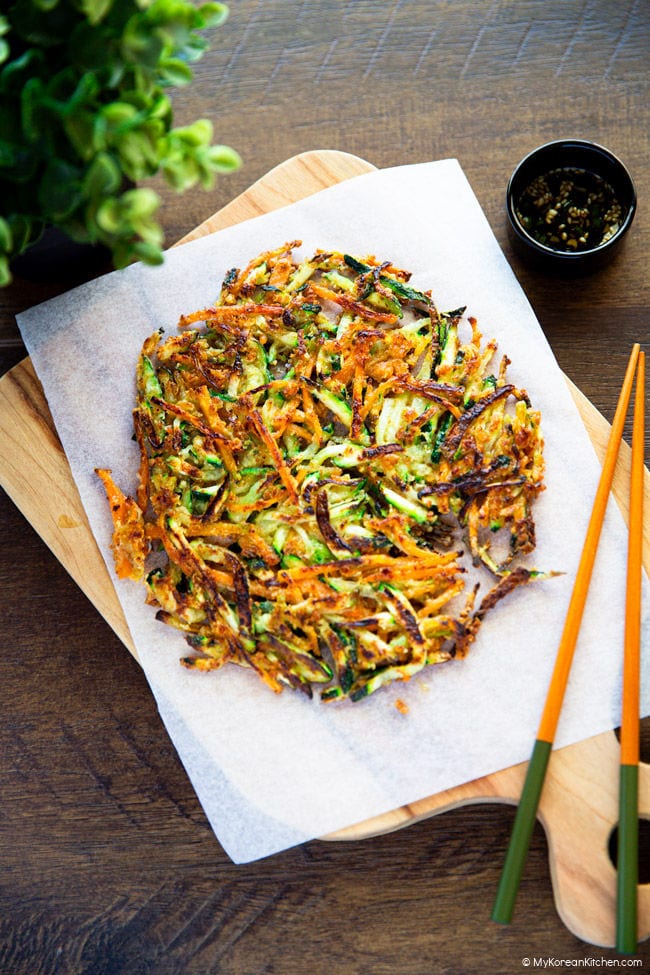
What Is Hobakchae Jeon?
Hobakchae jeon is a type of Korean zucchini pancake made with julienned zucchini (and often other vegetables), giving it a light, lacy texture and a delicate crispness when fried. This is quite different from hobak jeon, which is made with thicker round slices of zucchini dipped in batter and pan-fried.
Technically, hobak jeon is the broader term for zucchini pancakes, while hobakchae jeon specifically refers to this shredded, julienned version (“chae” means shredded in Korean). In everyday conversation though, many Koreans use hobak jeon to describe both styles, which is why you might see some people use the general term even for this version.
If you love hobak jeon, think of hobakchae jeon as its crispier cousin – perfect when you want something a little lighter and extra snackable, while still capturing that classic Korean jeon flavor.
Why You’ll Love This Recipe
Hobakchae jeon is everything I love about Korean pancakes – light, crisp, and so satisfying. The julienned zucchini creates those gorgeous lacy edges and tender centers, making it feel extra snackable while still full of that classic jeon flavor.
- Extra crispy edges with soft, tender centers in every bite
- Quick to prep and pan-fry in minutes (perfect for busy days!)
- Simple ingredients you likely already have in your kitchen
- Great as a snack, side dish, or even a party appetizer that always disappears fast
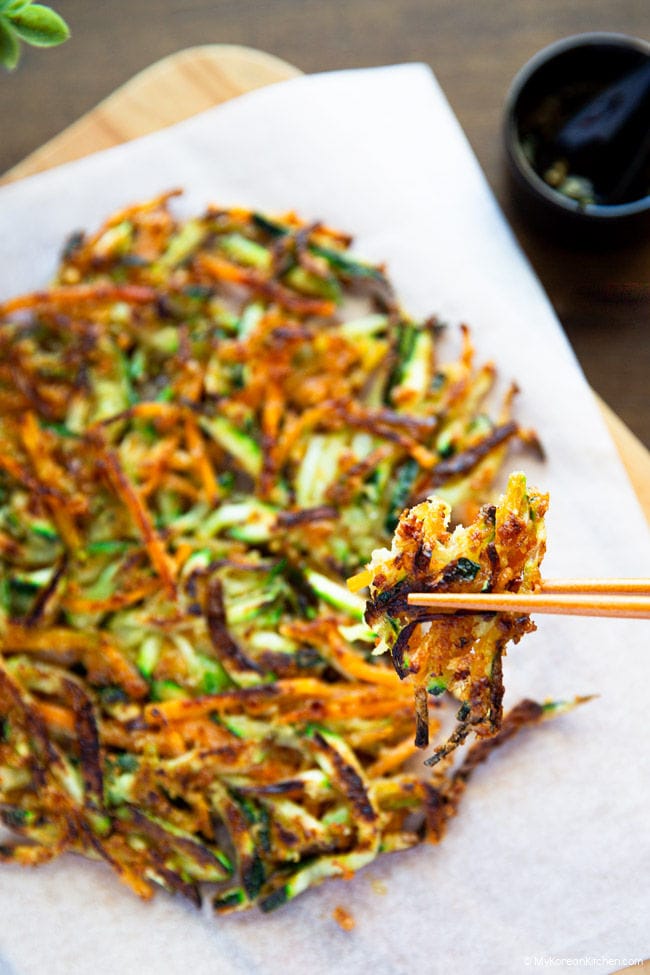
Rare Ingredients Highlights
I want to share two key ingredients that might be new to you if you’re just starting out with Korean cooking.
- Korean Pancake Mix
Korean pancake mix (Buchimgaru, 부침가루) is a seasoned flour blend made for savory pancakes like kimchi pancakes and seafood pancakes. Unlike plain flour, it’s pre-mixed with starches and seasonings, so your pancakes turn out crispy on the edges, light and tender inside, and full of flavor – no extra seasoning needed. It’s a foolproof shortcut and a staple in most Korean home kitchens.
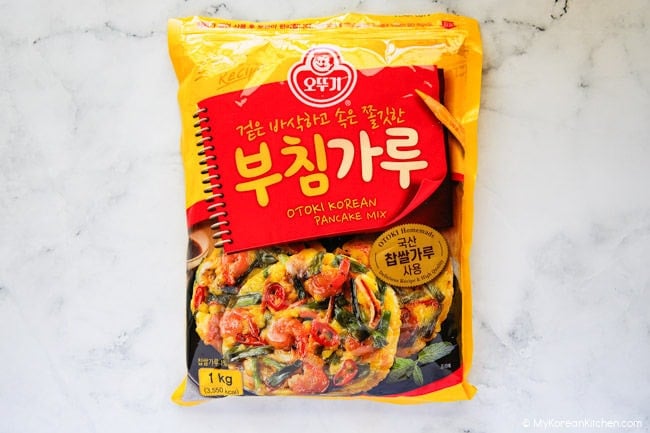
- Korean Dried Shrimps
Korean dried shrimp, called ‘geon saeu’ (건새우), are tiny shrimp that have been sun-dried until firm and intensely flavorful. They’re small but incredibly potent, packed with natural umami that instantly enhances the taste of any dish. Unlike fresh shrimp, they don’t need peeling or deveining – they’re ready to use straight from the package, and a quick dry-toasting in a pan brings out their nutty aroma while removing any fishiness.
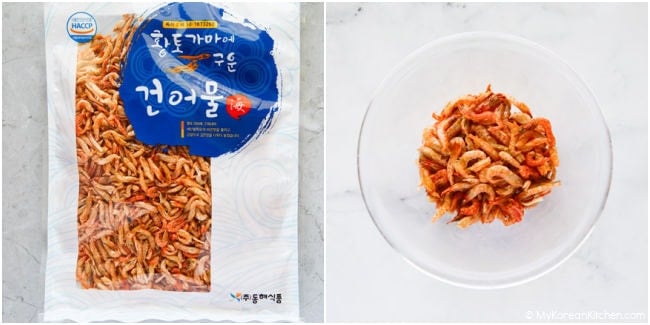
What You’ll Need
- 150 to 200 g (5.3 to 7.1 oz) zucchini
- 45 g (1.6 oz) carrot
- 1/4 tsp fine salt (a scant 1/4 tsp – fill your 1/4 tsp measure but leave it just slightly underfilled)
- 3 Tbsp dried shrimp (or substitute: 85 g / 3 oz fresh shrimp, squid, rockfish, or mussels)
- 1/4 cup Korean pancake mix (or substitute: 1/4 cup plain flour + 3/4 tsp cornstarch + 1/4 tsp fine salt + 1/4 tsp garlic powder + 1/4 tsp onion powder)
- 1/2 green or red chili (optional, for a spicy kick)
How to Make Crispy Korean Zucchini Pancakes (Step-by-Step)
Prep the vegetables:
Julienne the zucchini and carrot and place them in a mixing bowl. Sprinkle with the salt and toss to coat evenly. Let them sit for about 10 minutes. This light salting softens the vegetables and draws out just enough moisture to help bind the batter naturally – no extra water needed.
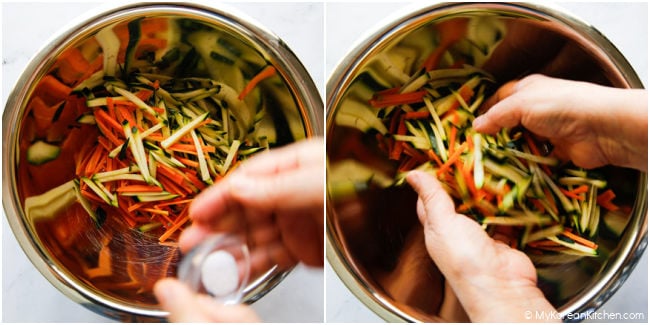
Prepare the seafood:
While the vegetables rest, dry-toast the dried shrimp in a pan over medium to medium-low heat for 1-2 minutes. This removes any fishiness and intensifies their nutty, savory aroma. Once fragrant, transfer to a cutting board and finely chop. (If using fresh shrimp, squid, rockfish, or mussels instead, simply chop them into small, fine pieces – no pre-cooking needed.)
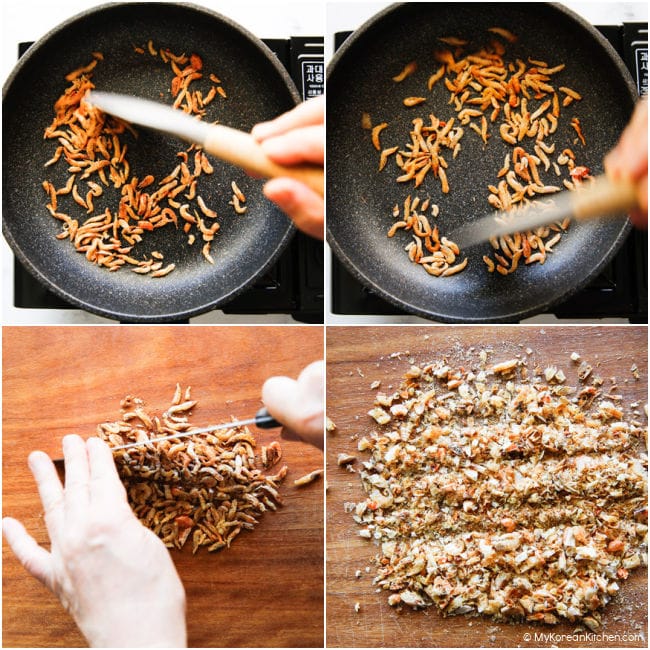
Mix the batter:
Add the chopped shrimp (or your seafood of choice) and the pancake mix to the salted vegetables. Stir until everything is evenly coated. The moisture from the salted vegetables is enough to bring the mix together, but the batter will look drier and chunkier than typical Korean pancakes with a pourable, liquid batter.
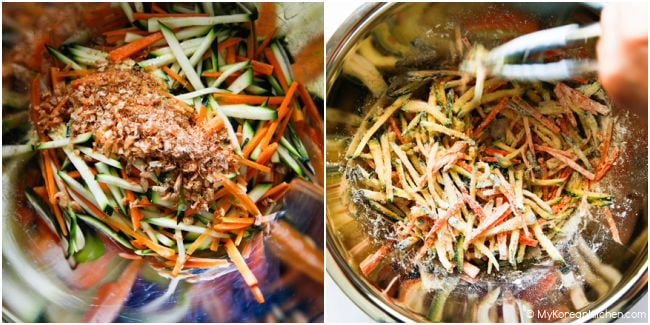
Cook the pancakes:
Heat a generous layer of oil in a pan over medium-high heat. Scoop a spoonful of the mixture into the pan and gently flatten it into a small round pancake. Cook for 2-3 minutes per side, or until golden brown and crisp. Add more oil between batches as needed to prevent sticking and maintain crispiness. Serve immediately and enjoy.
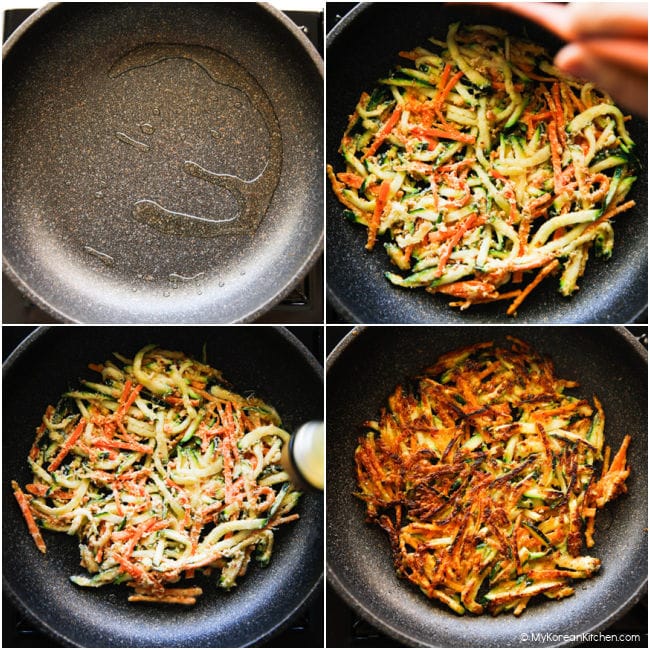
Tips for Success
- Light seasoning: Use a scant 1/4 tsp of salt to lightly season the vegetables and draw out a bit of moisture through osmosis. Don’t rinse or squeeze them afterward-the natural moisture helps bind the batter without adding water. This also concentrates the vegetables’ flavor and makes the pancakes crispier all the way through.
- Crispy edges: Make sure the pan and oil are well-heated before adding the batter. The hot oil instantly sears the vegetables, creating that beautiful golden color and delicate crunch.
- Shape and bind: Because this recipe uses very little added liquid or flour, most of what’s touching the pan is vegetables. Gently shape the pancakes in the pan as they cook – they’ll bind naturally in the hot oil and form cohesive, sturdy pancakes.
- Flipping like a pro: If you’re comfortable, try flipping the pancake in the pan with a quick wrist motion (like professional cooks do) instead of using a spatula. This keeps the pancake intact and prevents tearing since there’s no pressure point. If that feels intimidating, cook the pancake a little longer until it sets well, or use two spatulas to support it as you flip.
- Serve hot: These are at their crispiest when served right out of the pan. They’re well-seasoned and full of umami from the dried shrimp, so dipping sauce isn’t essential – but if you love dipping, you can pair them with my Korean pancake dipping sauce.
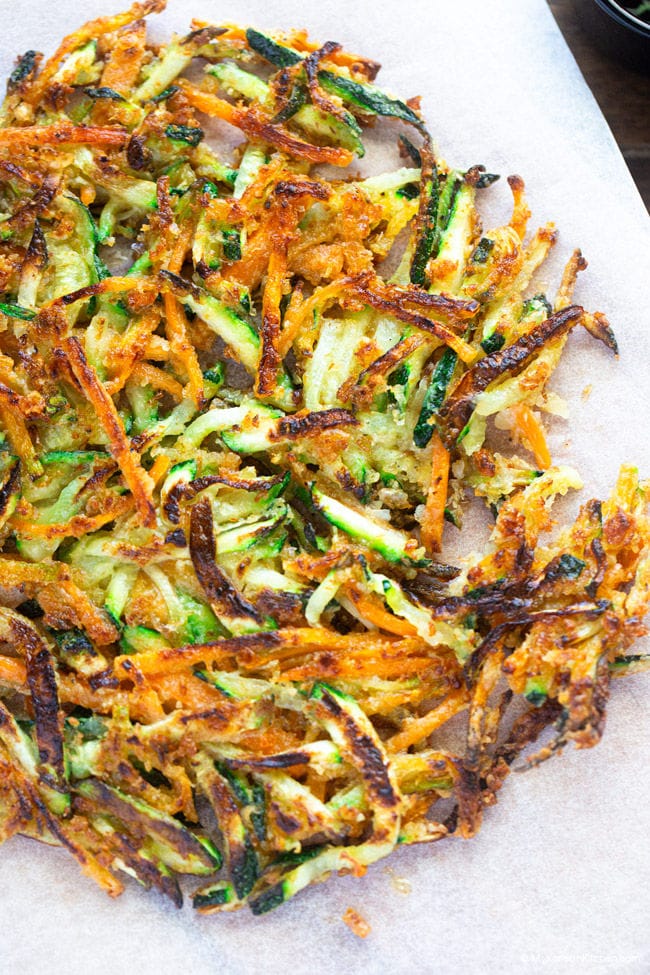
What to Serve With
- Pair with: Enjoy with Korean BBQ dishes like galbi or bulgogi, a bowl of steamed rice, or other jeon for a cozy, home-style Korean meal.
- Drink pairing: A chilled glass of makgeolli (Korean rice wine) is a classic match with jeon and makes this feel like a true Korean comfort food experience.
Storage and Reheating Tips
Honestly, these pancakes are best enjoyed fresh-right out of the pan when they’re at their crispiest. But if you do have leftovers, store them in an airtight container in the fridge for up to 1-2 days. To bring back the crisp, reheat them in a lightly oiled pan over medium heat or pop them into an air fryer. (Avoid microwaving, as it makes them soft and chewy.)
Other Korean Pancake Recipes You Might Like
If you love crispy Korean pancakes, try these next! From tangy kimchi pancakes to hearty mung bean pancakes, each one brings its own unique flavor and texture – perfect for mixing up your jeon game.
- Kimchi Pancakes (Kimchi Jeon)
- Seafood Pancakes (Haemul Pajeon)
- Potato Pancakes (Gamja Jeon)
- Mung Bean Pancakes (Bindaetteok)
Step-by-Step Video: How to Make It
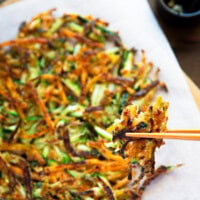
Crispy Korean Zucchini Pancakes (Hobakchae Jeon)
Ingredients
- 150 g zucchini ~200g (5.3 to 7.1 oz)
- 45 g carrot (1.6 oz)
- 1/4 tsp fine salt (a scant 1/4 tsp – fill your 1/4 tsp measure but leave it just slightly underfilled)
- 3 Tbsp dried shrimp (or substitute: 85 g / 3 oz fresh shrimp, squid, rockfish, or mussels)
- 1/4 cup Korean pancake mix (or substitute: 1/4 cup plain flour + 3/4 tsp cornstarch + 1/4 tsp fine salt + 1/4 tsp garlic powder + 1/4 tsp onion powder)
- 1/2 green chili or red chili (optional, for a spicy kick)
Instructions
- Prep the vegetables: Julienne the zucchini and carrot and place them in a mixing bowl. Sprinkle with the salt and toss to coat evenly. Let them sit for about 10 minutes. This light salting softens the vegetables and draws out just enough moisture to help bind the batter naturally – no extra water needed.
- Prepare the seafood: While the vegetables rest, dry-toast the dried shrimp in a pan over medium to medium-low heat for 1-2 minutes. This removes any fishiness and intensifies their nutty, savory aroma. Once fragrant, transfer to a cutting board and finely chop. (If using fresh shrimp, squid, rockfish, or mussels instead, simply chop them into small, fine pieces – no pre-cooking needed.)
- Mix the batter: Add the chopped shrimp (or your seafood of choice) and the pancake mix to the salted vegetables. Stir until everything is evenly coated. The moisture from the salted vegetables is enough to bring the mix together, but the batter will look drier and chunkier than typical Korean pancakes with a pourable, liquid batter.
- Cook the pancakes: Heat a generous layer of oil in a pan over medium-high heat. Scoop a spoonful of the mixture into the pan and gently flatten it into a small round pancake. Cook for 2-3 minutes per side, or until golden brown and crisp. Add more oil between batches as needed to prevent sticking and maintain crispiness. Serve immediately and enjoy.
Notes
- Make sure the pan and oil are well-heated before adding the batter. The hot oil instantly sears the vegetables, creating that beautiful golden color and delicate crunch.
- Gently shape the pancakes in the pan as they cook – they’ll bind naturally in the hot oil and form cohesive, sturdy pancakes.
- If you’re comfortable, try flipping the pancake in the pan with a quick wrist motion (like professional cooks do) instead of using a spatula. This keeps the pancake intact and prevents tearing since there’s no pressure point. If that feels intimidating, cook the pancake a little longer until it sets well, or use two spatulas to support it as you flip.
- These are at their crispiest when served right out of the pan. They’re well-seasoned and full of umami from the dried shrimp, so dipping sauce isn’t essential – but if you love dipping, you can pair them with my Korean pancake dipping sauce.
Nutrition Info (per serving)
The nutrition information shown is an estimate provided by an online nutrition calculator. It should not be considered a substitute for a professional nutritionist’s advice.
